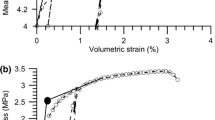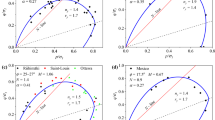Abstract
This paper presents a two-surface plasticity model for describing some important features of saturated clay under cyclic loading conditions, such as closed hysteresis loops, cyclic shakedown and degradation, and different stress–strain relations for two-way loading. The model, namely ACC-2-C, is based on the elastoplastic model ACC-2 (an adapted Modified Cam Clay model with two yield surfaces) developed by Hong et al. (Acta Geotech 11(4):871–885, 2015). The small-strain nonlinearity concept is adopted to achieve the nonlinear characteristics of clay during unloading–loading stage. The new hardening law related to accumulated deviatoric plastic strain is proposed for the inner surface to describe the cyclic shakedown and degradation. Following the advantages of the ACC-2 model, the constitutive equations are simply formulated based on the consistency condition for the inner yield surface. The model is conveniently implemented in a finite element code using a stress integration scheme similar to the Modified Cam Clay model. The simulation results are highly consistent with experimental data from drained and undrained isotropic cyclic triaxial tests in normally consolidated saturated clay under both one-way and two-way loadings.

















Similar content being viewed by others
Abbreviations
- A d :
-
Model parameter
- C :
-
Model parameter
- D e, D ep :
-
Elastic and elastoplastic stiffness matrix, respectively
- f B, f L :
-
Bounding surface and loading yield surface, respectively
- f Bc, f Be :
-
Bounding surface for compression and extension, respectively
- G :
-
Shear modulus
- G 1, G N :
-
Secant modulus at cycles 1 and N, respectively
- g B, g L :
-
Plastic potentials associated with bounding surface and loading yield surface, respectively
- h :
-
Hardening modulus
- K :
-
Elastic bulk modulus
- k :
-
Material constant
- k f, k g :
-
Model parameters for yield surface and plastic potential, respectively
- M f, M g :
-
Stress ratio at the apex of the yield surface and critical state slope, respectively
- M fc, M fe :
-
Stress ratio at the apex of the yield surface in compression and extension, respectively
- m :
-
Material constant
- p′, p′rev :
-
Mean effective stress at the current stress point and at the stress reversal point, respectively
- \(p_{c}^{{\prime }} ,\bar{p}_{c}^{{\prime }}\) :
-
Actual loading yield stress and conventional yield stress on the normal consolidation line, respectively
- q :
-
Deviator stress
- r :
-
Positive scalar defining the size of the loading field surface
- s 0 :
-
Model parameters
- \(s_{{{\text{c}}0}} ,s_{{{\text{e}}0}}\) :
-
Initial material constant under the first compression and extension cycle, respectively
- v 0 :
-
Initial specific volume
- u :
-
Pore water pressure
- X, X s :
-
Current stress state for mean effective stress and deviator stress, respectively
- \(\varepsilon\) :
-
Strain
- \(\varepsilon_{1} ,\varepsilon_{3}\) :
-
Axial and lateral strains, respectively
- \(\varepsilon_{\text{s}} ,\varepsilon_{\text{s}}^{\text{e}} ,\varepsilon_{\text{s}}^{\text{p}}\) :
-
Shear strain, elastic shear strain and plastic deviator strain, respectively
- \(\varepsilon_{\text{v}} ,\varepsilon_{\text{v}}^{\text{e}} ,\varepsilon_{\text{v}}^{\text{p}}\) :
-
Volumetric strain, elastic volumetric strain and plastic volumetric strain, respectively
- \(\varepsilon_{d}^{p}\) :
-
Total plastic strain
- \(\varepsilon^{1} ,\varepsilon^{N}\) :
-
Axial strains at cycles 1 and N, respectively
- \(\eta ,\eta_{\text{rev}}\) :
-
Normalized deviator stress at current stress point and at the stress reversal point, respectively
- \(\kappa ,\kappa_{0}\) :
-
Elastic slope and initial unloading slope in v − lnp′ space, respectively
- \(\varLambda\) :
-
Plastic multiplier
- \(\lambda\) :
-
Slope of the normal consolidation compression line
- \(\mu\) :
-
Poisson’s ratio
- \(\sigma\) :
-
Stress
- \(\sigma_{1}^{{\prime }} ,\sigma_{3}^{{\prime }}\) :
-
Axial and lateral effective stresses, respectively
- \(\omega\) :
-
Model parameter
- \(\zeta\) :
-
Degradation index
References
Al-Tabbaa A (1987) Permeability and stress-strain response of Speswhite kaolin. Ph. D Thesis, University of Cambridge, UK
Al-Tabbaa A, Wood DM (1989) An experimentally based bubble model for clay. Numer Methods Geomech NUMOG III:91–99
Baldi G, Hueckel T, Peano A, Pellegrini R (1991) Developments in modelling of thermo-hydro-geomechanical behaviour of boom clay and clay-based buffer materials. In: Commission of the European communities. European Commission, Brussels, Belgium
Dafalias YF (1986) Bounding surface plasticity. I: Mathematical foundation and hypoplasticity. J Eng Mech 112(9):966–987
Dafalias YF, Herrmann L (1980) A bounding surface soil plasticity model. In: International symposium on soils under cyclic and transsient loading, vol 1, Swansea, pp 335–345
Deng Y, Tang AM, Nguyen XP, Cui YJ (2011) Hydro-chemo-mechanical characterization of boom clays at essen. Post-doc report
Gasparre A (2005) Advanced laboratory characterisation of London clay. PhD thesis, Imperial College London, London
Hong PY, Pereira JM, Cui YJ, Tang AM, Collin F, Li XL (2014) An elastoplastic model with combined isotropic–kinematic hardening to predict the cyclic behavior of stiff clays. Comput Geotech 62:193–202
Hong PY, Pereira JM, Tang AM, Cui YJ (2015) A two-surface plasticity model for stiff clay. Acta Geotech 11(4):871–885
Hyodo M, Yamamoto Y, Sugiyama M (1994) Undrained cyclic shear behaviour of normally consolidated clay subjected to initial static shear stress. Soils Found 34(4):1–11
Jin YF, Yin ZY, Wu ZX, Zhou WH (2018) Identifying parameters of easily crushable sand and application to offshore pile driving. Ocean Eng 154:416–429
Kimoto S, Shahbodagh KB, Mirjalili M, Oka F (2015) Cyclic elastoviscoplastic constitutive model for clay considering nonlinear kinematic hardening rules and structural degradation. Int J Geomech 15(5):A4014005
Lê T (2018) Comportement thermo-hydro-mécanique de l’argile de Boom. PhD Thesis, Ecole Nationale des Ponts et Chaussees
Levasseur S, Malécot Y, Boulon M, Flavigny E (2008) Soil parameter identification using a genetic algorithm. Int J Numer Anal Meth Geomech 32(2):189–213
Li T, Meissner H (2002) Two-surface plasticity model for cyclic undrained behavior of clays. J Geotech Geoenviron 128(7):613–626
Li XL, Bernier F, Vietor T, Lebon P (2011) Thermal impact on the damaged zone around a radioactive waste disposal in clay host rocks-technical annex 1. Final report to EC (Contract Number: FI6 W-CT-2007-036449) EUR
Mróz Z (1981) An anisotropic critical state model for soils subjected to cyclic loading. Géotechnique 31:451–469
Mróz Z, Norris VA, Zienkiewicz OC (1979) Application of an anisotropic hardening model in the analysis of elasto–plastic deformation of soils. Géotechnique 29(1):1–34
Nakai T, Hinokio M (2004) A simple elastoplastic model for normally and over consolidated soils with unified material parameters. Soils Found 44(2):53–70
Papon A, Riou Y, Dano C, Hicher PY (2012) Single-and multi-objective genetic algorithm optimization for identifying soil parameters. Int J Numer Anal Meth Geomech 36(5):597–618
Roscoe KH, Burland J (1968) On the generalized stress-strain behaviour of wet clay. In: Heyman J, Leckie FA (eds) Engineering plasticity. Cambridge University Press, Cambridge, pp 535–609
Sangrey DA, Henkel DJ, Esrig MI (1969) The effective stress response of a saturated clay soil to repeated loading. Can Geotech J 6(3):241–252
Simpson B (2010) Engineering in stiff sedimentary clays. Géotechnique 60:903–911
Sridhanya KV, Rajagopal K, Lakshmana RC (2008) Modelling of degradation of clayey soils under repeated loading. In: The 12th international conference of international association for computer methods and advances in geomechanics (IACMAG), pp 877–882
Stallebrass SE (1990) Modelling the effect of recent stress history on the deformation of overconsolidated soils. PhD Thesis, City University, London, London
Stipho A (1978) Experimental and theoretical investigation of the behavior of anisotropically consolidated kaolin. PhD Thesis, Cardiff University, UK
Wheeler SJ, Näätänen A, Karstunen M, Lojander M (2003) An anisotropic elastoplastic model for soft clays. Can Geotech J 40(2):403–418
Whittle AJ, Kavvadas MJ (1994) Formulation of MIT-E3 constitutive model for overconsolidated clays. J Geotech Eng 120(1):173–198
Wichtmann T, Triantafyllidis T (2017) Monotonic and cyclic tests on kaolin: a database for the development, calibration and verification of constitutive models for cohesive soils with focus to cyclic loading. Acta Geotech 13(5):1103–1128
Xiong YL, Ye GL, Xie Y, Ye B, Zhang S, Zhang F (2018) A unified constitutive model for unsaturated soil under monotonic and cyclic loading. Acta Geotech. https://doi.org/10.1007/s11440-018-0754-2
Yin ZY, Karstunen M, Chang CS, Koskinen M, Lojander M (2011) Modeling time-dependent behavior of soft sensitive clay. J Geotech Geoenviron 137(11):1103–1113
Yin ZY, Xu Q, Chang CS (2013) Modeling cyclic behavior of clay by micromechanical approach. J Eng Mech 139(9):1305–1309
Yin ZY, Xu Q, Hicher PY (2013) A simple critical-state-based double-yield-surface model for clay behavior under complex loading. Acta Geotech 8(5):509–523
Yin ZY, Jin YF, Shen SL, Huang HW (2016) An efficient optimization method for identifying parameters of soft structured clay by an enhanced genetic algorithm and elastic–viscoplastic model. Acta Geotech 12(4):849–867
Yin ZY, Jin YF, Shen JS, Hicher PY (2018) Optimization techniques for identifying soil parameters in geotechnical engineering: comparative study and enhancement. Int J Numer Anal Meth Geomech 42(1):70–94
Yin ZY, Wu ZX, Hicher PY (2018) Modeling monotonic and cyclic behavior of granular materials by exponential constitutive function. J Eng Mech 144(4):04018014
Yu HS, Khong C, Wang J (2007) A unified plasticity model for cyclic behaviour of clay and sand. Mech Res Commun 34(2):97–114
Zentar R, Hicher PY, Moulin G (2001) Identification of soil parameters by inverse analysis. Comput Geotech 28(2):129–144
Zhou J, Gong X (2001) Strain degradation of saturated clay under cyclic loading. Can Geotech J 38(1):208–212
Zienkiewicz OC, Mróz Z (1984) Generalized plasticity formulation and applications to geomechanics. In: Desai CS, Gallagher RH (eds) Mechanics of engineering materials. Wiley, New York, pp 655–679
Zymnis DM, Whittle AJ, Cheng X (2018) Simulation of long-term thermo-mechanical response of clay using an advanced constitutive model. Acta Geotech. https://doi.org/10.1007/s11440-018-0726-6
Zytynski M (1978) On modeling the unloading-loading behaviour of soils. Int J Numer Anal Meth Geomech 2(1):87–93
Acknowledgements
The present work was carried out with the support of the National Key Research and Development Program of China (2016YFC0800207), National Natural Science Foundation of China (41472244, 51608188), the Provincial Key Research and Development Program of Hunan (0105679005), the Industrial Technology and Development Program of Zhongjian Tunnel Construction Co., Ltd. (17430102000417).
Author information
Authors and Affiliations
Corresponding author
Additional information
Publisher's Note
Springer Nature remains neutral with regard to jurisdictional claims in published maps and institutional affiliations.
Rights and permissions
About this article
Cite this article
Chen, RP., Zhu, S., Hong, PY. et al. A two-surface plasticity model for cyclic behavior of saturated clay. Acta Geotech. 14, 279–293 (2019). https://doi.org/10.1007/s11440-019-00776-z
Received:
Accepted:
Published:
Issue Date:
DOI: https://doi.org/10.1007/s11440-019-00776-z




